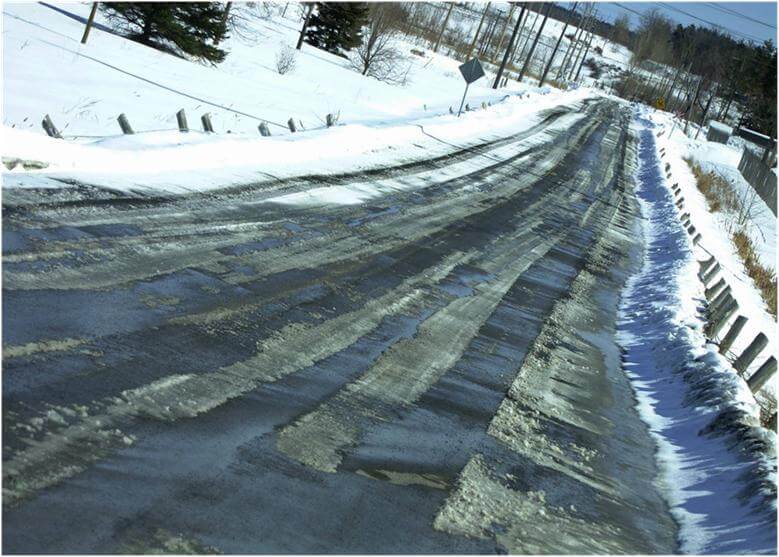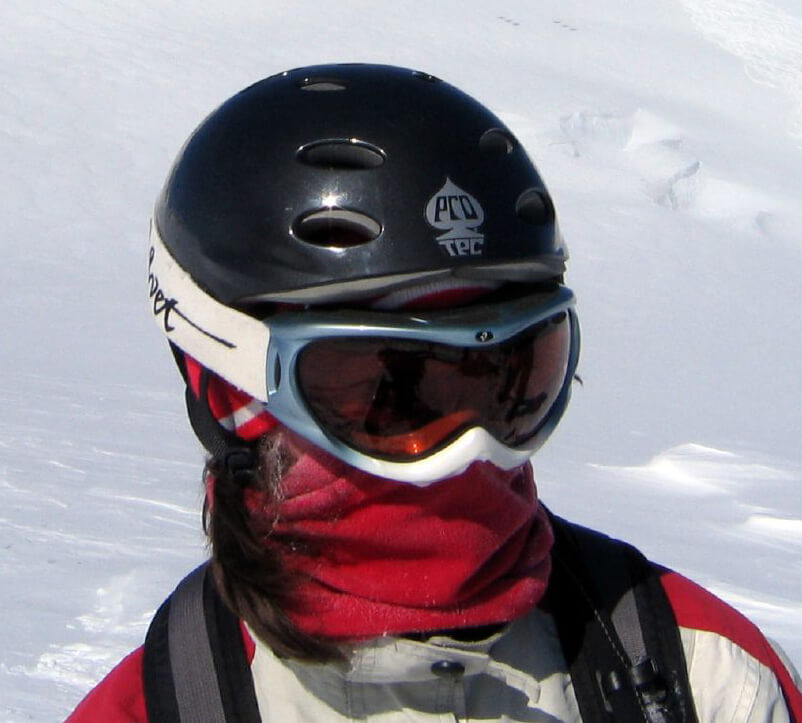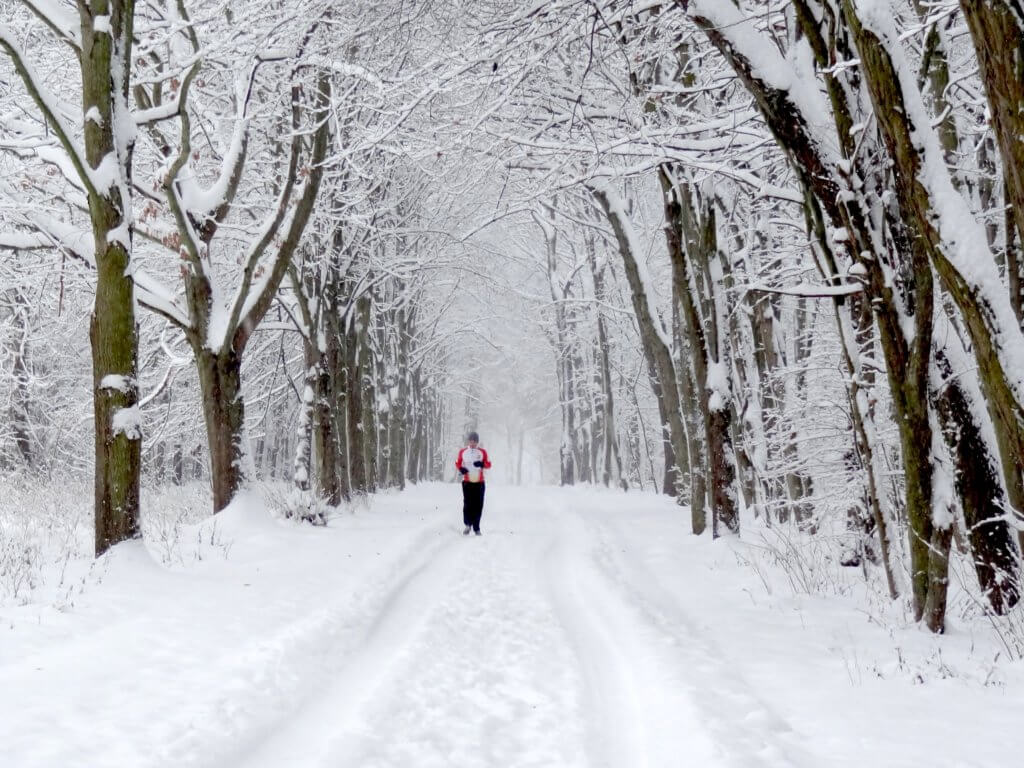When temperatures drop but you’ve made a resolution to run more in 2020, you might feel like you’re trapped between an icy rock and a hard place. But if you wear the right gear and approach your run with the right attitude, you’ll be keeping pace with your goals before you know it.

Here are six things to keep in mind as you run in freezing weather:
Wear the right clothes and shoes.
You might be tempted to dress like the snowboarder pictured below, but running in cold weather requires lighter, looser gear. Think layers — air trapped between your layers of clothing can be insulation against the cold. And remember that you’ll get warmer as you run; the general rule is to dress like it’s about 20 degrees warmer than what it actually is, so you will be a little chilly when you start running.

The weather you’ll face outside will also affect your outermost layers. If there is snow or slush, you’ll want to wear shoes that are weatherproof or at least have very little mesh, in order to keep your feet dry. If the wind is blowing or the temps are freezing, cover as much skin as possible, including your neck, face and chin. And if visibility is low because of snow or fog, wear a reflective jacket or flashing light — or both — to make sure that drivers, cyclists and other pedestrians can see you.
Warm up for your run inside.
It takes longer to warm up your body in cold weather, says Mitch Kaye, a physical therapist and the Director of Quality Assurance for PTPN (the parent company of Physiquality). Jump some rope, ride a stationary bike, or even do some burpees or jumping jacks to warm up your body before going outside. This will also help you understand if you’ve put on too much clothing — if you’re sweating before you’ve even started your run, you probably need to remove a layer before heading out.
Don’t measure yourself against your summer statistics.
Your winter runs won’t look the same as your warm weather runs for a variety of reasons. Your body may not get as much oxygen during extremely cold weather, making it more difficult to complete a long run. Your strides may not be as long because you’re trying to avoid icy patches on your trail. Or it may simply be too cold to stay out as long as you do in better weather. Focus on the fact that you’re still sticking to your goals, even if you have to adapt how you’re reaching them.

Be safe.
Take your cell phone on your run, and make sure it’s fully charged before you go. Try not to run alone, particularly at night or when there is low visibility. If you don’t have a running buddy to go with you, adds Mitch, be sure to tell a friend or family member about your planned run, and text or call them again once you’re home. And stay aware of your surroundings, especially if you run while wearing headphones.
Change your clothes as soon as you’re back from your run.
Staying in damp, sweaty clothes after a long run can lower your core temperature and put your health at risk, Mitch notes. Put on some fresh clothes as soon as you’re inside, and drink some hot chocolate or eat some soup as well in order to regulate that body temp and avoid hypothermia.
Pay attention to your body.
As with any exercise, listen to what your body is saying. If you’ve been back from your run for a couple of hours but are still shivering, or if you’re slurring your speech or confused, these are signs of hypothermia — which means you need to see a doctor right away.

It’s also important to pay attention to how your muscles feel after your run. Colder temperatures can weaken your muscles, increasing the chance for injury. If you experience intense pain after your run, or if you have pain persisting for multiple days that does not subside with rest, talk to your physical therapist.
Are you looking for a physical therapist to help keep you running well? Use our locator below to find a Physiquality physical therapist near you.
Thank you to our contributors:

Mitch Kaye, PT, is the Director of Quality Assurance for PTPN, the parent company of Physiquality. He oversees all aspects of utilization review and case management for the entire PTPN network, and trains and supervises PTPN’s Quality Assurance and Utilization Management staff. In addition, he is responsible for creating and updating case management, utilization management, quality assurance, clinical integration and outcomes guidelines for the network.
Triola, Paige. The best safety tips for running on the roads or trails. Runners World, May 24, 2019.
Mayo Clinic.
- Frostbite. March 20, 2019.
- Hypothermia. March 13, 2019.
Schwecherl, Laura. 3 simple things I do to make winter running more enjoyable. Self, December 8, 2018.
No, MiHyun and Hyo-Bum Kwak. Effects of environmental temperature on physiological responses during submaximal and maximal exercises in soccer players. Integrative Medicine Research, September 2016.
Gray, Aaron. Winter running tips. MU Health Care.
Scott, E. E. F. and A. H. R. W. Simpson. Increased risk of muscle tears below physiological temperature ranges. British Bone and Joint Research, February 2016.
Preparing for your first race. Physiquality, September 1, 2015.
“Me” by Ruth and Dave is licensed under CC BY 2.0.
“Running in the snow” by Michał Bielecki is licensed under CC BY-SA 2.0.